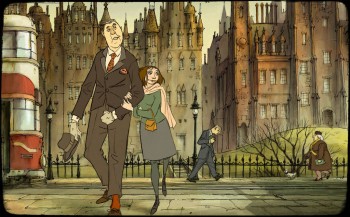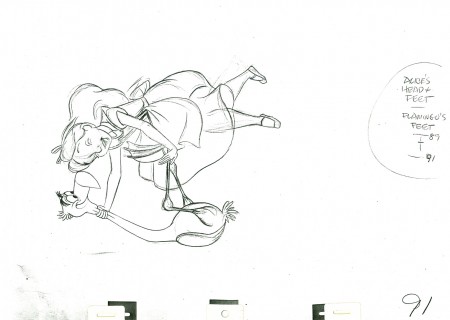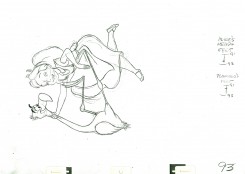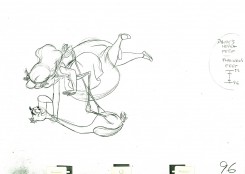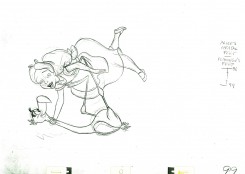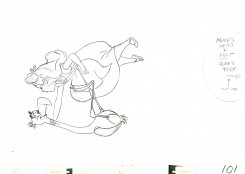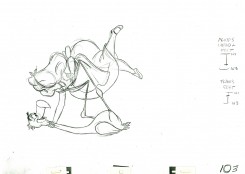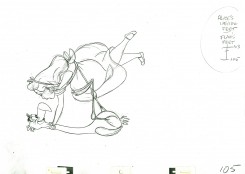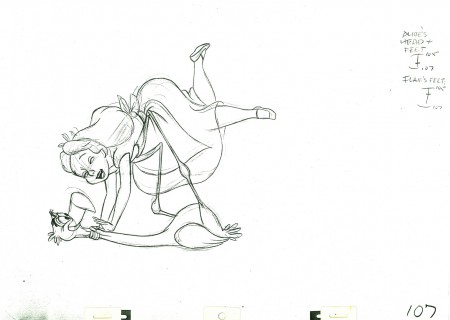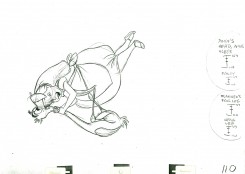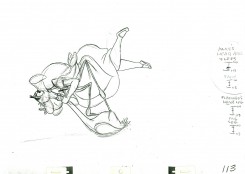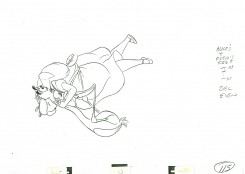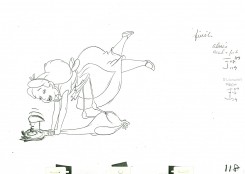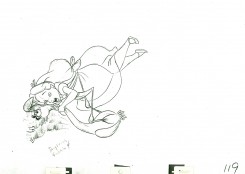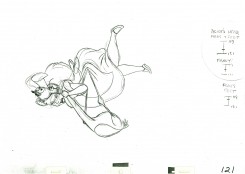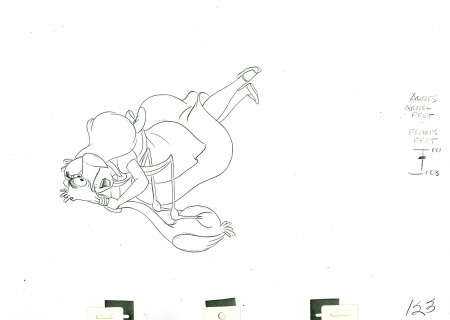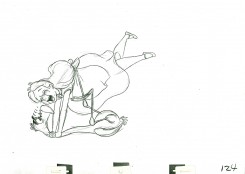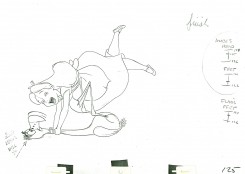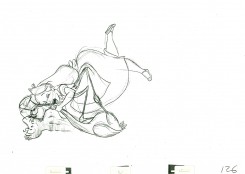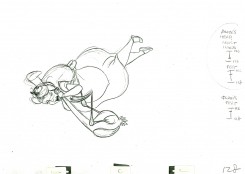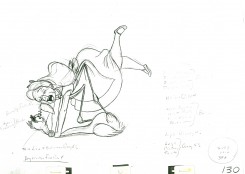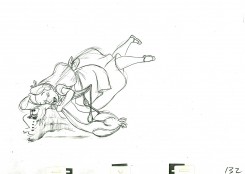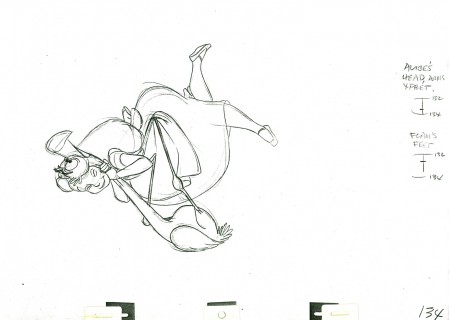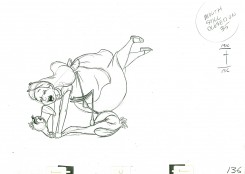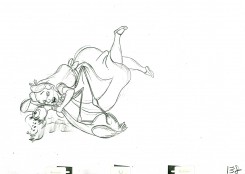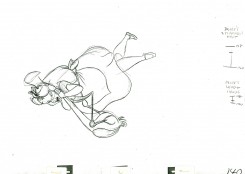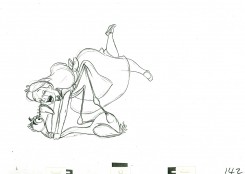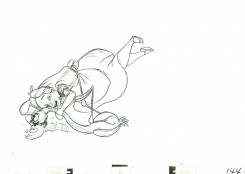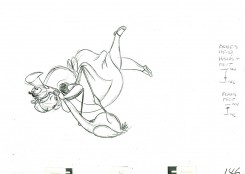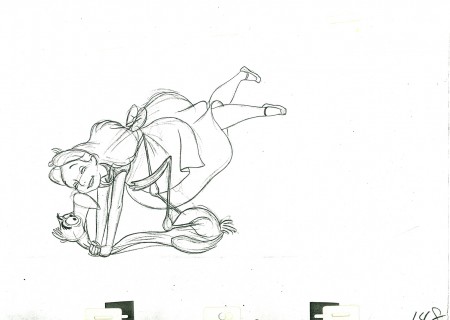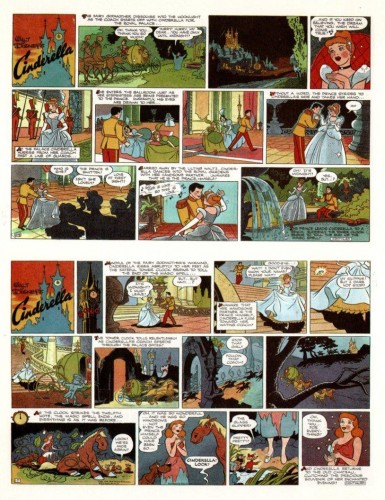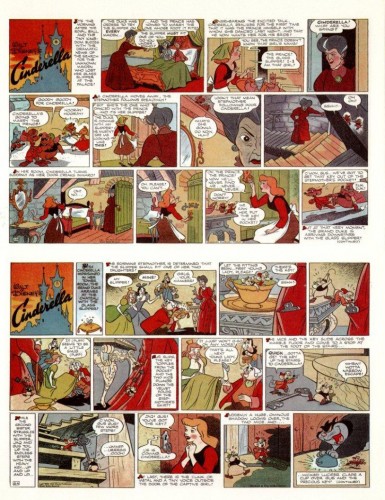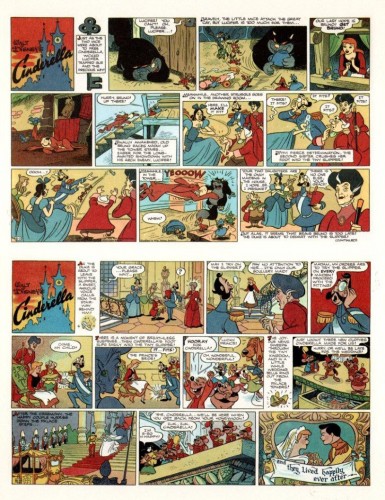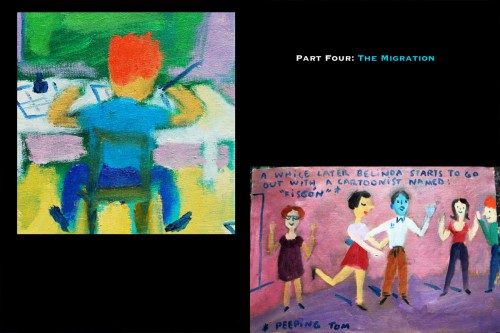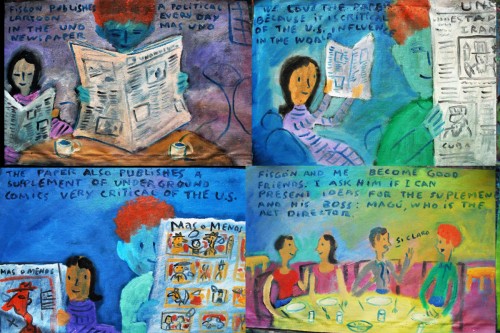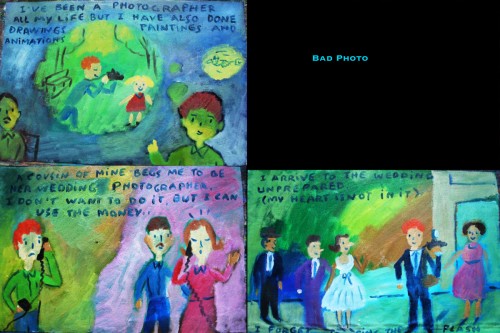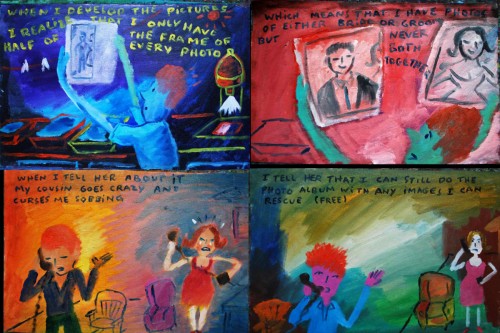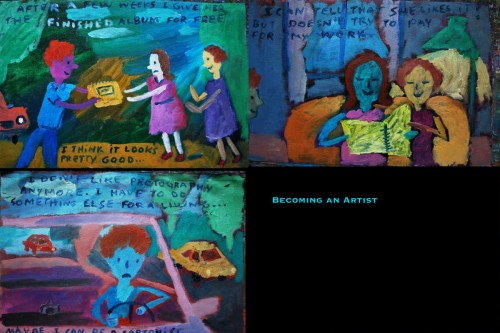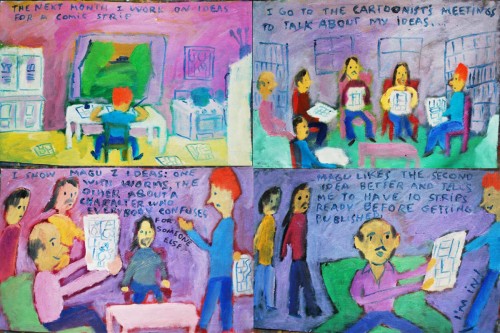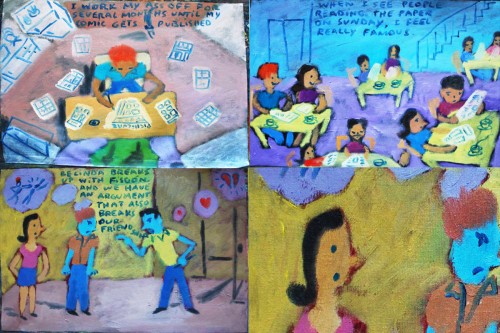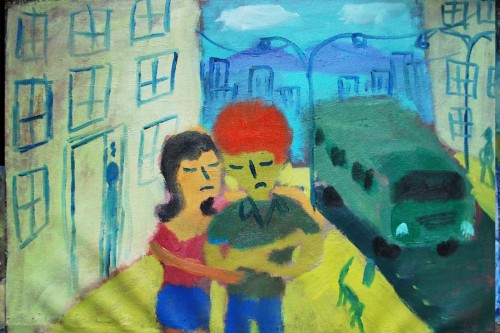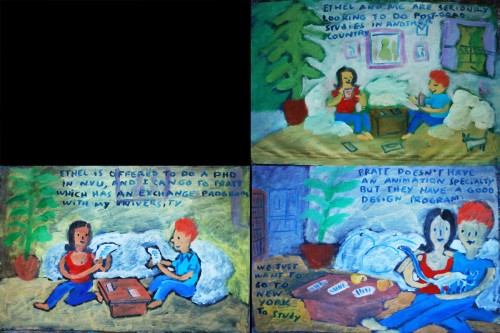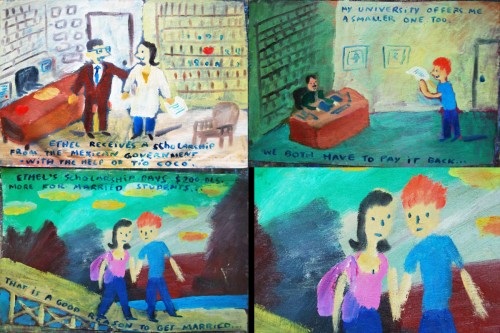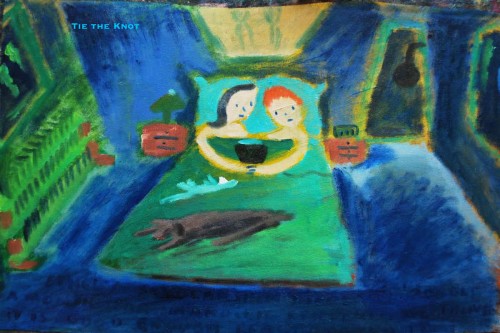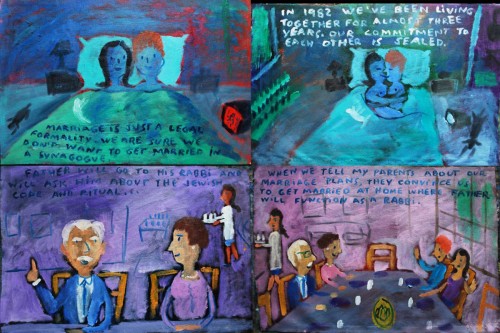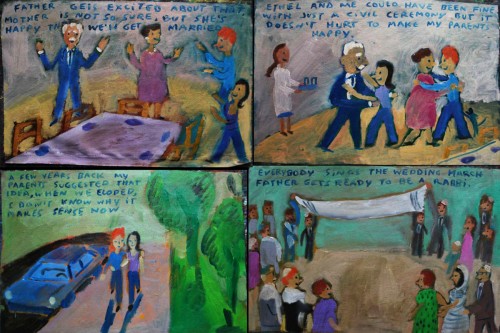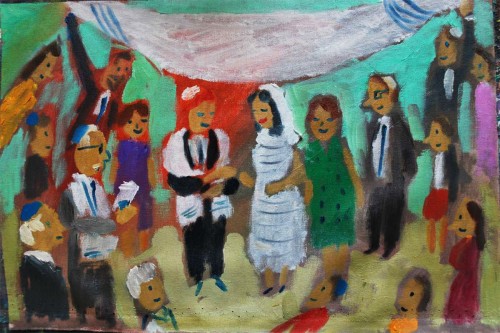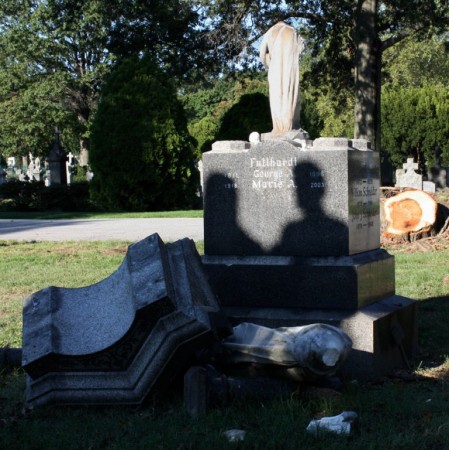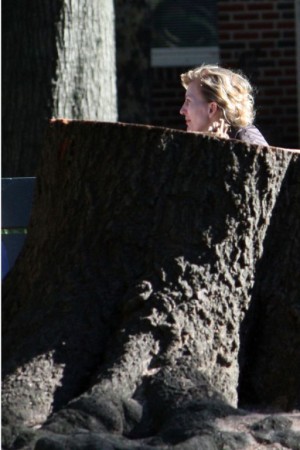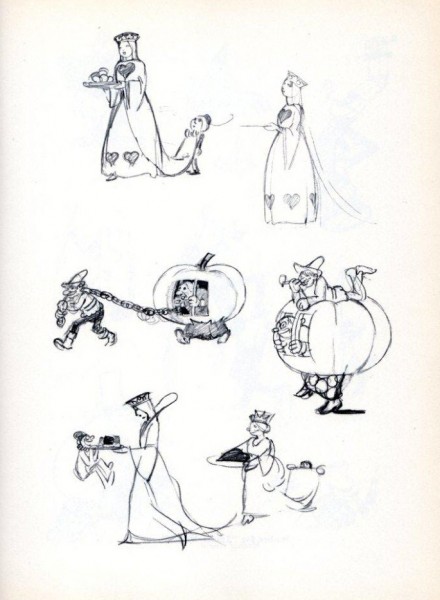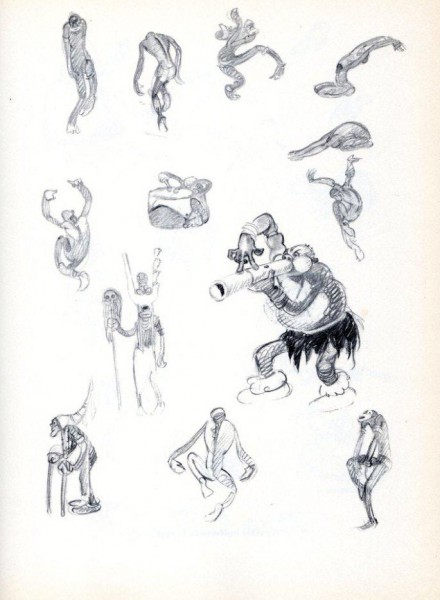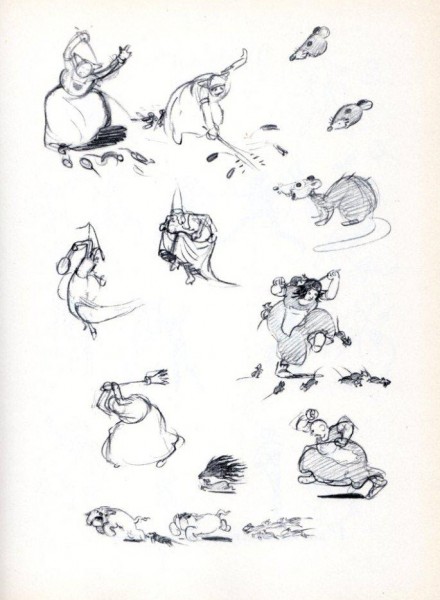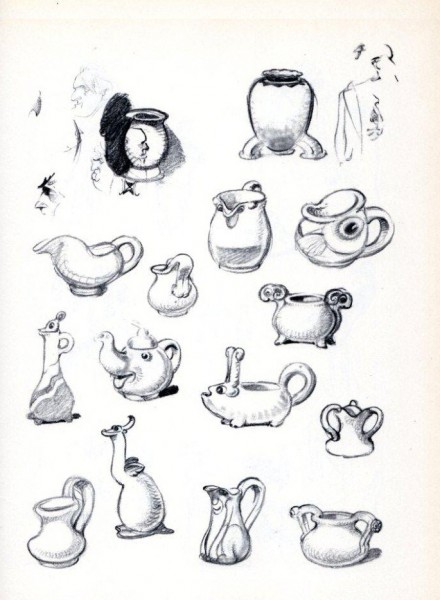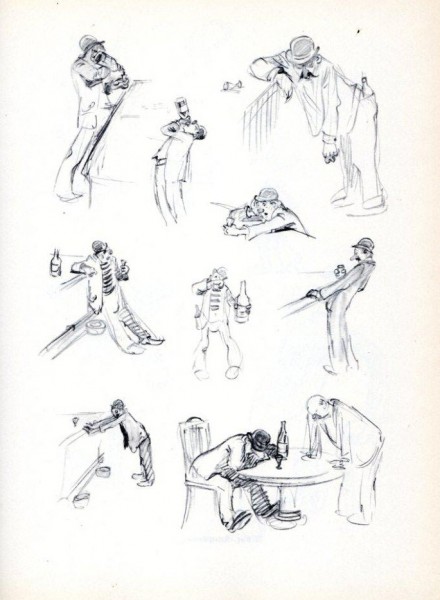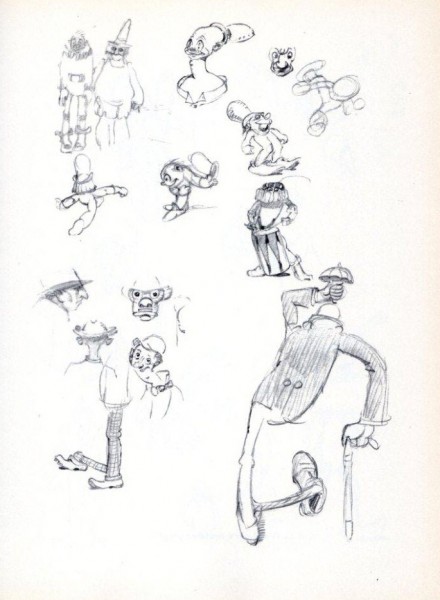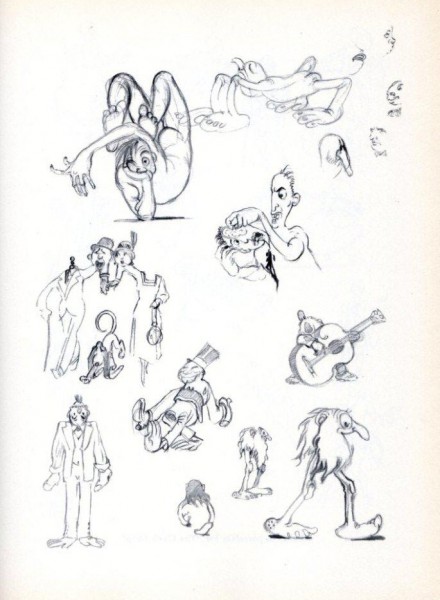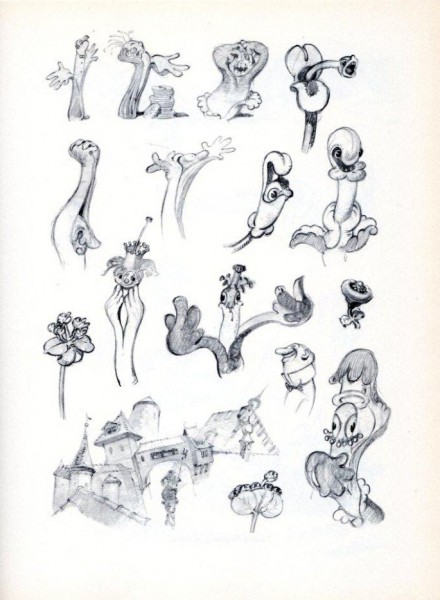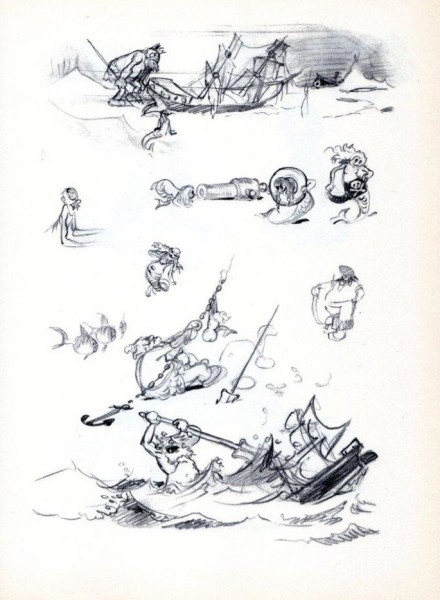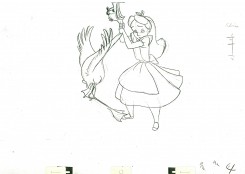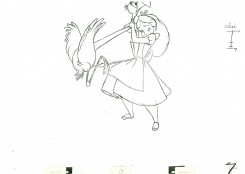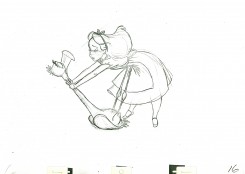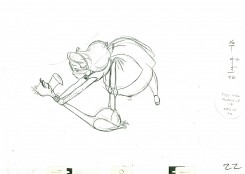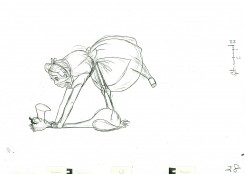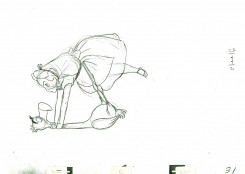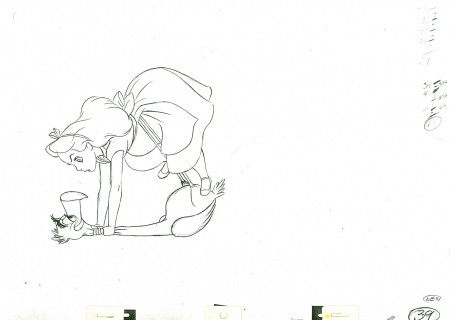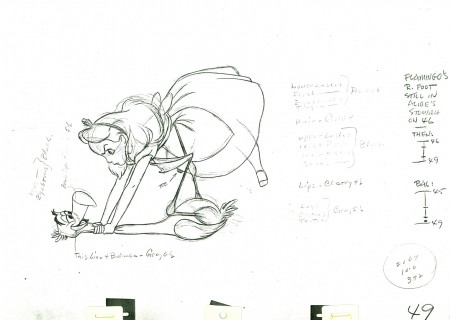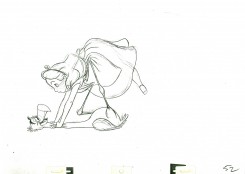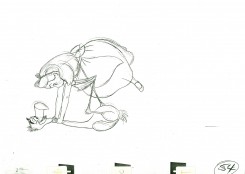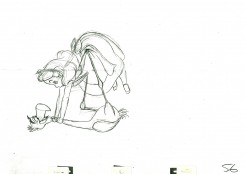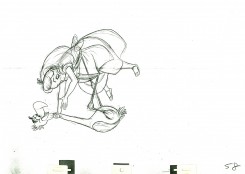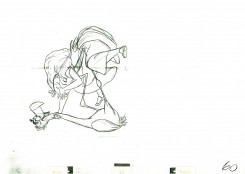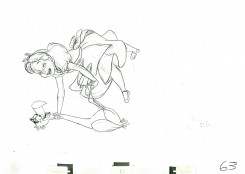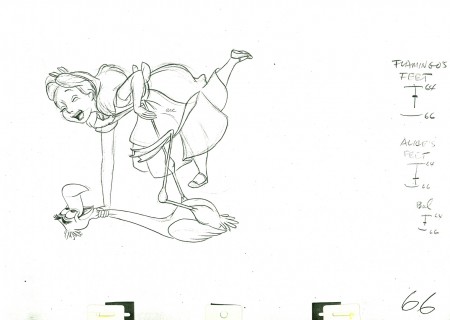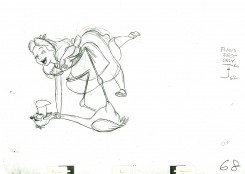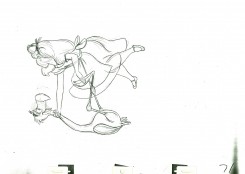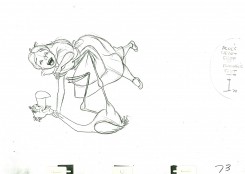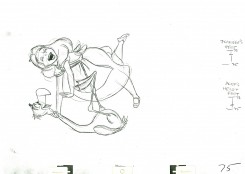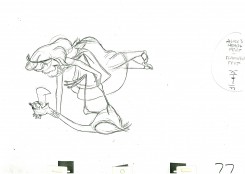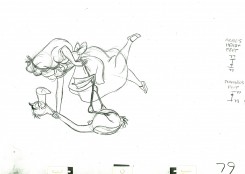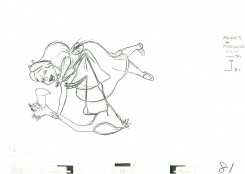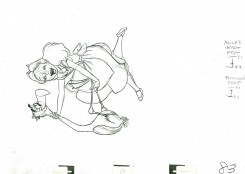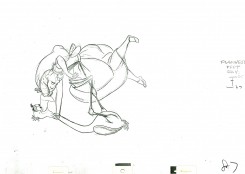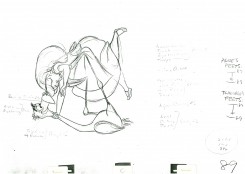Monthly ArchiveNovember 2010
Independent Animation 11 Nov 2010 08:53 am
My Thoughts on The Illusionist
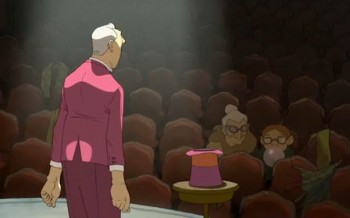 - Last night, I saw Sylvain Chomet‘s film, The Illusionist. I truly thought it was brilliant – acting more as a film than an animated film. At the moment it feels like one of the better films this year. I think I need to see it another time or two for me to write about it properly, but I’ll try here, anyway.
- Last night, I saw Sylvain Chomet‘s film, The Illusionist. I truly thought it was brilliant – acting more as a film than an animated film. At the moment it feels like one of the better films this year. I think I need to see it another time or two for me to write about it properly, but I’ll try here, anyway.
First let me talk about Chomet’s first feature, The Triplettes of Belleville. The promo for that film, online, was the first 3 or 4 minutes of the film. A wild takeoff of some thirties style animation that beat to the rhythm of the Oscar nominated song from the film. In the feature, this promo turned out to be a television image that the two leads watched in their small house. Immediately, you were into the story of a mother (grandmother?) helping her child who’s devoted to bicyce riding. They spend all their efforts on his career with a lifetime of training for the Tour de France. The film has such a wonderful sense of design, you’re spending much of your time ignoring the fine animation in front of you to take in the details on the backgrounds.
For a while, that movie worked wonderfully for me. Characters are fully and wonderfully developed – without dialogue. However, I think it goes wrong at the point where the bike riding boy is kidnapped and taken to Belleville. Even when you get to Belleville, you have to be taken by the scenery.
But the story has gone askew. Some gang types have kidnapped the boy to run a faked indoor race for the sake of gambling. Grandma, with the help of the singing triplettes of Belleville, rescues the boy and kill off the gang’s members. The gang members are a difficult design to swallow: square-backed look-a-like creatures that merge into one another with their modular form. They’re the only characters in the film not based on human form, and they come off as unacceptable, for my taste. I’d already left the story, the design of these characters pushed me out of the film.
It was Chomet’s first feature. It had its shortcomings but was still the best animated feature I’d seen in years.
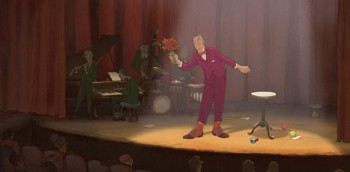 Now Chomet has completed his second feature, and has far eclipsed what he’d done before it. It possibly helps that the film was written by Jacques Tati just prior to his death and sat unmade since 1959. The form, the structure, and indeed the style all came courtesy of Tati. And the results are beautiful and excellent. The animation, the best done in many years, comes courtesy of Chomet, and it is brilliant.
Now Chomet has completed his second feature, and has far eclipsed what he’d done before it. It possibly helps that the film was written by Jacques Tati just prior to his death and sat unmade since 1959. The form, the structure, and indeed the style all came courtesy of Tati. And the results are beautiful and excellent. The animation, the best done in many years, comes courtesy of Chomet, and it is brilliant.
Prior to seeing this film, many evocative clips were placed on line. Like the one longer clip for Belleville, these had my mouth salivating for great 2D animation. Triplettes didn’t quite make it; the clips for this film give us the mood of The Illusionist, but the actual feature goes all the way and more.
Prior to seeing this film, I’d read several very positive reviews from professional critics in papers such as The Guardian, Movieline, and Variety.
There were also the reviews from snarky commentors like the one who talked about wanting to walk out on all three viewings. (Hint: you don’t go to a film three times wanting to walk out on all three! Something is suspect. This review was placed verbatim on several sites.)
But then there is also the on-line review by the astute Mark Mayerson at his website calling the film: “Chomet’s best film yet, one that combines his eccentrics with a melancholy tale of age and youth.”
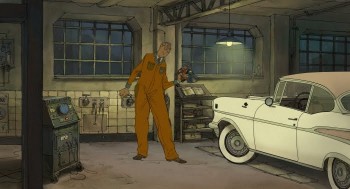 Undeniably, the film moves at a relaxed, comfortable pace. It doesn’t try to be the wham-bam-loud screaming films Pixar and Dreamworks make. It moves slowly and naturally like a Jacques Tati film. The humor isn’t hard-edged and in your face à la How To Train Your Dragon or Toy Story 3. The characters don’t scream their dialogue (the habit of animation films for the past twenty years or so); in fact they don’t have any dialogue.
Undeniably, the film moves at a relaxed, comfortable pace. It doesn’t try to be the wham-bam-loud screaming films Pixar and Dreamworks make. It moves slowly and naturally like a Jacques Tati film. The humor isn’t hard-edged and in your face à la How To Train Your Dragon or Toy Story 3. The characters don’t scream their dialogue (the habit of animation films for the past twenty years or so); in fact they don’t have any dialogue.
The action is done mostly in mime. A word is heard every so often, but they’re irrelevant. This was also Chomet’s scheme in Triplettes, and it worked well. Music is at the heart of his animation. However, it doesn’t feel completely natural here – a touch forced. I thought if there were a scene in the beginning where the magician and his ward spoke different languages to each other. If she spoke Hungarian and he French, and there were no interpretation, both the principal characters and the audience would be left out, for the most part.
The young girl follows him to the point where he feels obligated to take care of her, almost adopting her temporarily. This point seemed to bother several people I talked with. Richard O’Connor on his blog Asterisk Pictures takes exception to it and questions its political correctness. I found it completely innocent and had NO problem whatsoever. However, Mark Mayerson nicely compares it to Chaplin’s Limelight. There, an older performer takes care of a young ballet dancer. It’s a smart association to have made. I also saw other films in there. Just this Tuesday I’d watched Local Hero Bill Forsyth’s little gem of a film. The mood was perfect in both films showcasing the Scottish countryside. The backgrounds, the animation, the lighting, the delicacy of the direction (rarely are CloseUps found – it’s all establishing and Long Shots. There’s a grand scheme here. It’s a wonderful film.
An excellent interview with Chomet was printed in The Guardian just prior to the film’s unveiling at the Edinburg Film Festival back in June. I encourage you to read the whole. This is a small quote from it on the Disney/Dreamworks statements about the death of 2D animation: “. . . American reflex to kill off the competition, to say that you can only do it one way and destroy everything else that went before. The whole society is like that. They destroy what they have to build something new. They end up with no roots to draw on, nothing to compare their work with to see if it is good or not. American culture is in real danger of starving itself to dead. You just have to see what Hollywood is producing to see how narrow it is getting.”
Mayerson said:
-
“Some films become touchstones; they remain part of the conversation years after their release. For some part of the animation community, The Illusionist will be a touchstone.”
I can’t put it better, and I can’t say any louder that this is undeniably, to me, the best animated feature I’ve seen in, at least, the last 10 years. It’ll eventually reach you. It opens Christmas Day in NY & LA to qualify for the Oscar. It’ll come to your town in 2011.
See it if you love animation and/or film.
Animation &Animation Artifacts &Disney 10 Nov 2010 08:43 am
Milt Kahl’s Alice – 2
- This is a continuation of Scene 392 from Alice in Wonderland as animated by the brilliant Milt Kahl. The animation seems to play a bit fast in the PT, but works well in color (albeit still fast.) Yet the exposure is the same. Definitely, the missing inbetweens make the difference.
As always, we start with the last drawing from last week.
_________________________
Here’s a QT movie of the action layed out above. Since there are no inbetweens contained within the scene, each drawing is exposed in the QT for the dial number on the sheet.
Bill Peckmann &Comic Art &Disney 09 Nov 2010 08:21 am
Cinderella Strip – 2
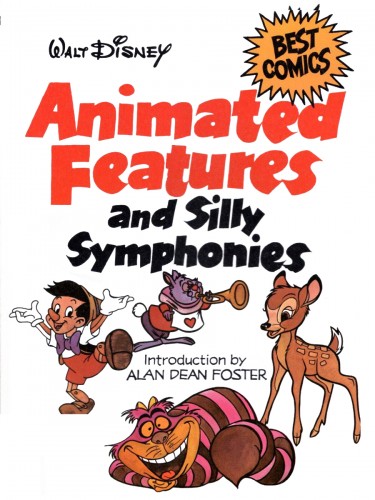
.
- A couple of weeks ago, I posted the first half of a Cinderella comic strip that Bill Peckmann sent me from the book, Animated Features and Silly Symphonies.
This is a hard-to-get book, so it’s a treat to see these strips. They’re dated 1950, and each page contains 2 Sunday strips. Cinderella features artwork by Manuel Gonzales, penciler, and Dick Moores, inker. Moores, of course, took over the Gasoline Alley strip from Frank King. His line work was always beautiful and these strips show it off.
Here, we finish out the story started on October 14th. many thanks, again, to Bill Peckmann.
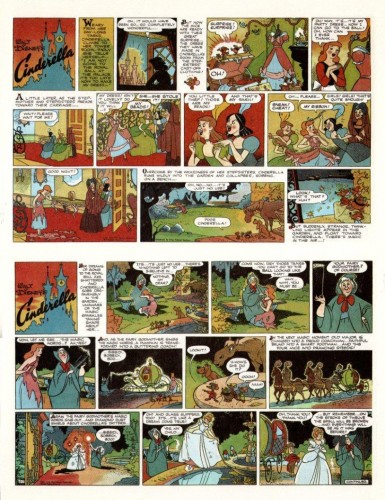 51
51(Click any image to enlarge.)
Art Art &Illustration 08 Nov 2010 07:52 am
“Ex Vida†from Santiago Cohen – 5
- It’s Monday, so that means we’re back in the world of Santiago Cohen whose Ex Vida has been occupying our blog. This is a beautifully drawn and painted autobiography Santiago has produced.
To see prior parts of this post:
Part 1, Part 2, Part 3, Part 4
Needless to say, you have to enlarge the frames to properly appreciate the brilliance of this work. As they say on the street, check it out.
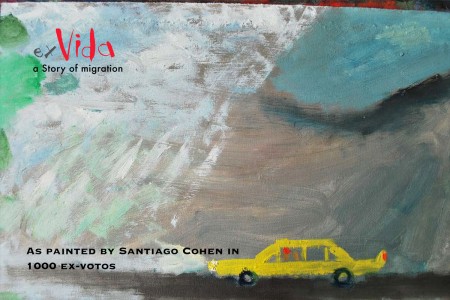 1
1(Click any image to enlarge.)
Photos 07 Nov 2010 08:45 am
Treestumps
Here’s a note I received from my friend, Steve Fisher:
- A month ago, I was invited by the Queens Chronicle to participate in a photo assignment involving the tree stumps around town in the aftermath of the tornados that swept through Middle Village this fall. The charge was, ‘Be creative.’ I happily went to work surveying the area and ultimately submitted over a dozen shots that I thought might be worthy of the photo essay QC had planned. Inexplicably, nothing further has come of them to date – nothing has been published in the several subsequent issues of QC, and no response to a number of email queries as to the status of the project. So I’d like to share them with you.
Upon first blush, I felt that a stump was a stump was a stump. But looking around, I began to appreciate that each stump is distinct and has its own story. The challenge became to find the more interesting stories. What makes a photo of a stump artistic, after all? Its color, shape composition. For me, the more successful shots are those that transcend what is being photographed – sometimes using scale to add to the mystery of the image – making the viewer ask, ‘ What am I looking at?’
Needless to say, I’m posting them all. Enjoy.
 1
1(Click any image to enlarge.)
Commentary &Disney 06 Nov 2010 08:26 am
MOMA screening
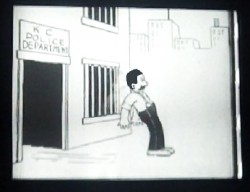 - On Thursday, this week, I went to the Museum of Modern Art to see the reconstructed prints of the Laugh-O-Grams they were screening. These were among the first series Disney produced in Kansas City. Apparently, four of the seven titles were missing, and found within the MOMA library mislabelled.
- On Thursday, this week, I went to the Museum of Modern Art to see the reconstructed prints of the Laugh-O-Grams they were screening. These were among the first series Disney produced in Kansas City. Apparently, four of the seven titles were missing, and found within the MOMA library mislabelled.
The Laugh-O-Grams were originally produced for a man named Frank Newman, a local theater owner. They were designed as quick sketch movies with an animated hand seemingly drawing illustrations which would end up as quick gags or ads for local merchants. The first film shown was one of these films, and it’s probably the one of those that I most enjoyed.
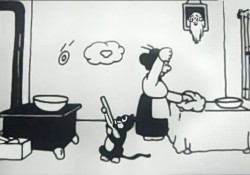 Eventually, Walt and his staff started making a story film for themselves, trying to improve the product. Little Red Riding Hood was finished within six months and they began work on the Four Musicians of Bremen.
Eventually, Walt and his staff started making a story film for themselves, trying to improve the product. Little Red Riding Hood was finished within six months and they began work on the Four Musicians of Bremen.
MOMA screened both these films as well as the found others. They were all British prints attributed to Bollman and Grant, credited as producers for the New York-based Sound Film Distributing Corp; in England, Wardour Films distributed these films. They were headlined as “Peter the Puss” films, which Disney had called “Julius the Cat.”
All of the films had new titles:
Little Red Riding Hood was called Grandma Steps Out.
Goldilocks and the Three Bears was called The Peroxide Kid.
Puss In Boots was The K-O Kid
Cinderella was The Slipper-y Kid
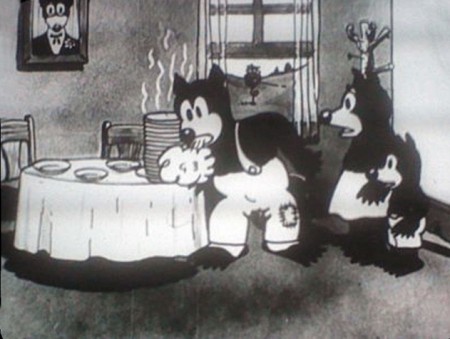
The Peroxide Kid AKA Goldilocks and the Three Bears.
It was a treat seeing these all projected with a live piano accompaniment that started as stiffly as the animation in the films, but soon grew very lively and filled with a sense of fun.
The films made me think of all the Flash animation being done today with much more limited results than these unknowledgeable beginners were able to pull off back in 1922. These guys were making up an industry and having more fun doing it than most of what I see on a screen today. (Actually, it’s more YouTube and Vimeo than a real screen. Perhaps if it were harder to get the films screened more imagination would go into them.) I wish there had been more animators in attendance at the Museum show and hope that they went to the first screening last Sunday.
The screening ended with a never-ending supply of Ub Iwerk’s films in glorious Cine-color. There’s nothing that’ll make things more attractive than an Aqua and Orange pallette. I’ve seen all of these films a hundred times if I’ve seen them twice, so I was not ready to make my way through an hour’s worth of them. If I’d been alone, I would have left.
The attempt was made to keep the fairy tales by Disney playing with fairy tales by Iwerks. I would have preferred seeing some of the later Iwerks Willie Whopper films. Those have a really odd side to them, and their backgrounds are most peculiar as well as the live jazzy soundtracks employed.
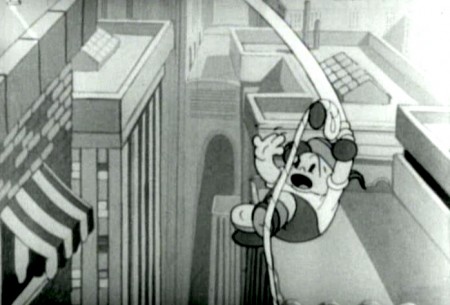
Willie Whopper, The Good Scout hung out to dry.
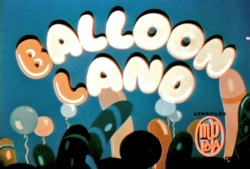
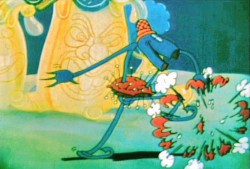
Balloon Land aka The Pincushion Man is probably the oddest of Iwerks’ work.
It played to near absolute silence.
I met Mike Barrier for the show; he was in town for the weekend with his wife, Phyllis, celebrating a key wedding anniversary. David Gerstein and Tom Stathes also joined us. David, with some help from Tom, was instrumental in identifying these films. It was nice to finally meet the two of them; Mike and I have been old friends for a long time.
Animation Artifacts &Bill Peckmann &Books &Disney &Illustration 05 Nov 2010 07:23 am
He Drew As He Pleased – 3
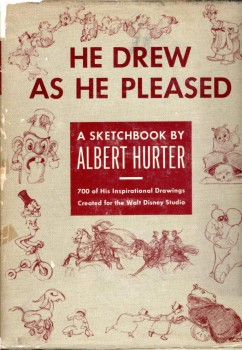 - Here’s another follow up to the Albert Hurter book, He Drew As He Pleased (Simon and Schuster, 1948.)
- Here’s another follow up to the Albert Hurter book, He Drew As He Pleased (Simon and Schuster, 1948.)
Hurter, of course, was one of those exceptional European illustrators Disney brought into his studio in preparation for Snow White and Pinocchio. Hurter, as the title implies, was the master of his own fate, drawing designs which would be used generally to further the design of the features and Silly Symphonies.
Many thanks to Bill Peckmann for the loan of the book’s pages and the arduous task of scanning these illustrations.
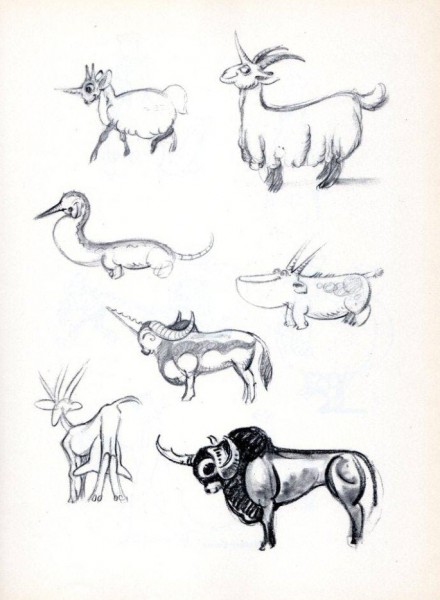 35
35
Albert’s animals had a tendency to face Westward.
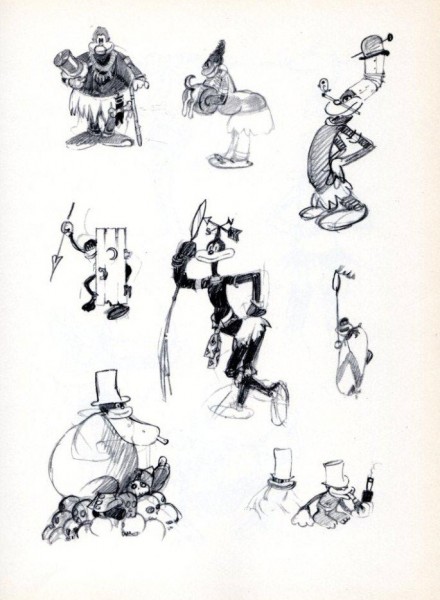 37
37
Studies for “Trader Mickey”.
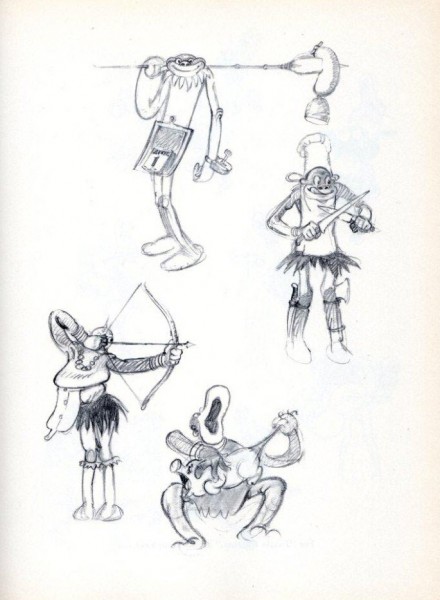 38
38
More studies for “Trader Mickey”.
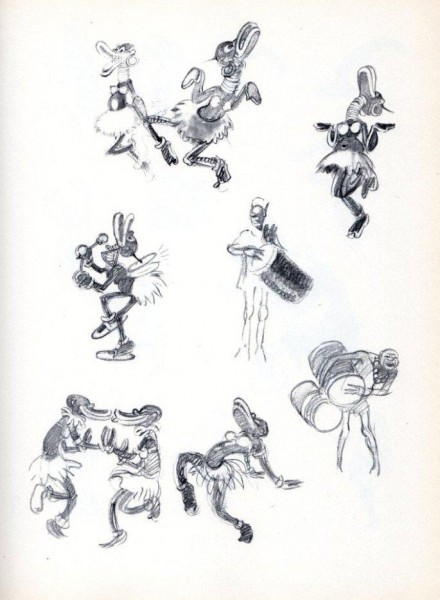 39
39
For “Jungle Rhythms” a Silly Symphony.
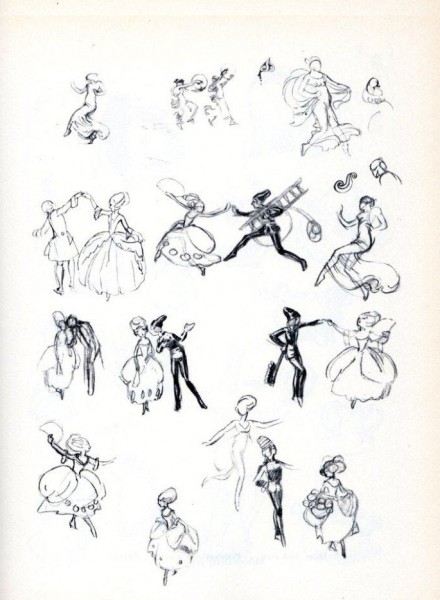 42
42
Hans Christian Andersen’s “Princess and the Chimney Sweep”.
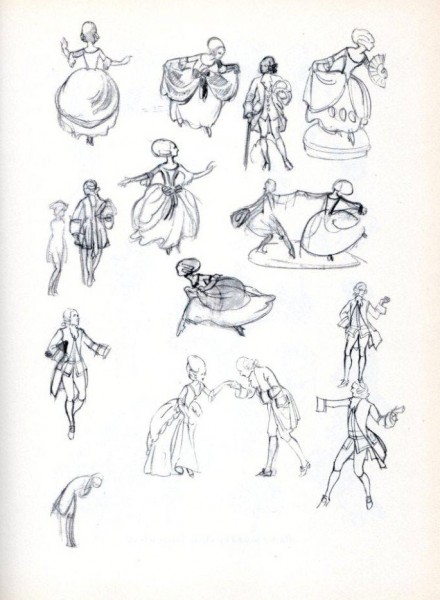 47
47
Minuet In Porcelain for the Clock Shop.
To see the other posts from this book: Part 1, Part 2
Articles on Animation 04 Nov 2010 07:11 am
Animation Renaissance
- I enjoy rereading some of the articles in older magazines that talk about the “current state” of animation. We get to see, in hindight, what was thought of the industry during a time of change.
This article from Horizon Magazine, was written by John Canemaker in 1980, some 15 years before Toy Story and the serious explosion of cgi would take place in 1995. Many thanks to John for the article.
Animation. Renaissance ?
From Disney to independents,
animation continues to thrive.
By John Canemaker
Every few years the press alternately declares animation to be enjoying a “renaissance” or predicts the medium’s gloomy future. In the early 1970s, while Ralph Bakshi was riding a crest of popularity with the success of his cartoon features, Fritz the Cat (1972) and Heavy Traffic (1973), animation was rediscovered and pronounced “born again!” Last September, a dozen animators quit the Walt Disney studio and joined Aurora, a film production company started by three former Disney executives. Aurora is spending $7 million to produce a feature-length cartoon of a Newberry Award-winning children’s book by Robert C. O’Brien, Mrs. Frisby and the Rats of NIHM. Ironically, Mrs. Frisby is a mouse, and, back at the Mouse Factory (as the Disney studio was nicknamed in the 1930s), the premiere of a new cartoon feature, The Fox and the Hound, had to be postponed for six months because of the departure of one-sixth of the animation department. With the recent Disney defections, the pundits (including the New York Times) lamented the “serious gap” in Disney’s creative ranks and noted that the animation industry (and, by implication, the art of animation) had been “long depressed.”
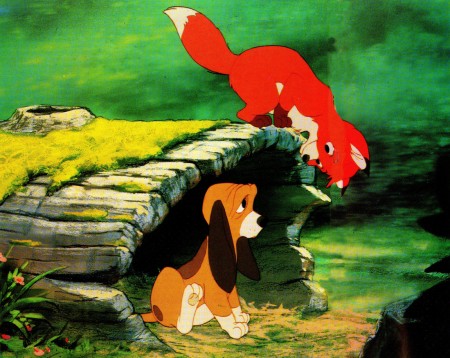
When a dozen animators quit Walt Disney, The Fox
and the Hound, Disney’s twenty-fourth animated feature,
had to be postponed for six months.
Nothing could be further from the truth. Further, the tacit assumption that Disney and the cartoon-film industry represent the
total contemporary animation scene—or even the most important part of it—is a benighted one.
Disney, to be sure, is a great and beloved name, synonymous with animation to the general public; but Disney today is only part of an international art form comprised of a dazzling variety of styles, techniques, and content. Animation continues to thrive and flourish as it has for more than eighty years, not only in industry-run cartoon studios that produce TV series, commercials, specials, and feature-length theatrical films, but in the experimental, personal alternative forms of motion graphics created by the swelling ranks of independent animation-film and -video makers.
Regarding the current Disney situation, it is important to know that it is not an unprecedented event. At least twice before, Disney artists have left the studio en masse — and each time the result was positive for both Disney and the animation industry. In 1928, for example, Walt Disney lost rights to a cartoon character named Oswald the Rabbit; at the same time he suffered the departure of some of his key animators. Oswald was replaced by a new character—Mickey Mouse—and Disney soon enlarged his staff with a corps of artists who, within a decade, advanced character animation to a new plane. Two of the 1928 defectors went on to form the Warner Brothers cartoon studio and, later, the MGM cartoon studio.
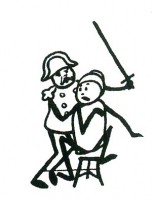 In 1941, a large contingent of employees participated in a strike at the Disney studio that crippled production for several weeks.
In 1941, a large contingent of employees participated in a strike at the Disney studio that crippled production for several weeks.
One effect of that walkout was Disney’s eventual diversification into areas other than animation, such as live-action features, nature documentaries, television, Disneyland, and Walt Disney World. The financial security derived from such variegation allows Disney to continue making animated features. Some of the 1941 strikers formed a new studio, United Productions of America (UFA), which revolutionized the design of studio cartoons by moving away from the ultranaturalistic Disney style toward bolder graphics rooted in modern art.
An illustration from_______ Animation production manager Don A. Duckwall revealed that
Le Cuchemar du Fantoche__ despite the recent walkout at Disney, “things are going
a 1908 short by Emile Cohl.__ along beautifully. There is a resurgence of enthusiasm for the
_______________________ product and the future.” Duckwall feels the defection has “cleared the air,” and the studio has promoted peopie who are ‘ ‘taking the responsibility and doing leadership work” on TheFoxandiht Hound feature. So confident is Ron Miller, Disney executive vice-president for creative affairs, that he has scheduled the long-awaited fantasy epic The Black Cauldron as the studio’s next animated-feature project.
“Another benefit of all the publicity about the ones who left,” explains Duck-wall, “is the tremendous number of portfolios being submitted by people wanting to join our animation training program. We now have eight trainees, which is a goodly number for us.” Paula Sigman, assistant archivist at the Walt Disney Archives, confirms the positive effect of the changeover; “Instead of sounding the death knell in the animation department, this has been like a breath of fresh air—to hear the rest of the young guys tell it. There’s a new feeling of unity, of openness and willingness to communicate, of ambition. And although they’re pushed back on Fox and Hound, they’re quite excited.”
Don Bluth, the forty-two-year-old leader and spokesman for the animators who left Disney, said the resignations were “trig- ‘ gered by a dispute over training practices and artistic control.” He plans to make their feature, Mrs. Frisby, in the Disney mode (“It’s the style we love!”), but claims “the content will be different.” Mike Barrier, editor of Funnyworld, a periodical devoted to animation and comic art, has commented that “the real reason the group ! left is not that they want to go beyond what Disney has already done, but because the present studio is not ‘Disney’ enough!”
It is too early to tell if Bluth and company will succeed with their first solo venture and go on to take animated features into areas uncharted by Disney or if the Disney studio itself can succeed with this new creative challenge. The missing factor this time around is, of course, the powerful healing presence of Walt Disney himself; but certainly the competition of the two studios in the area of animated features is a healthy one for animation.
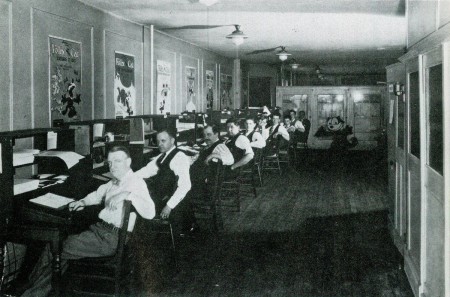
Otto Messmer (second from left) created Felix the Cat
at the Pat Sullivan studio in NY around 1919.
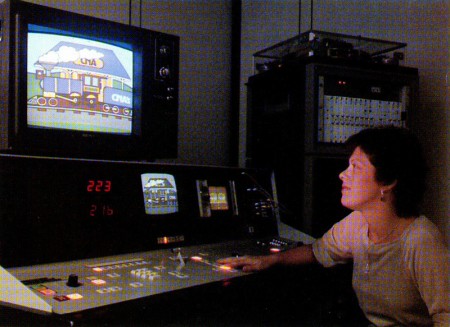
Computers such as Computer Creations “Videocel”
technique are being used today to cut production costs.
The last decade has seen an astonishing increase in the number of animated features produced by studios other than Disney. This trend can be traced back to The Yellow Submarine (1968) directed by George Dunning in London. A still-fresh, pop-art fairy tale of our times, starring the magical Beatles, it is a milestone film that redefined the stylistic and narrative borders of animated features. It also tapped a lucrative nontraditional cartoon-feature market composed of young singles and teenagers as well as attracting the usual family-kiddie audience.
Ralph Bakshi confirmed the existence of this “other” audience with his two aforementioned X-rated cartoons, which, though sloppy structurally, were compel-lingly earthy and poetic. They explored darker, more sensual themes and emotions than Disney dared to. Of a dozen animated features released in the last three years, several aimed toward a wider audience: Watership Down, Lord of the Rings, Allegro Non Troppo, and Dirty Duck. Internationally, there are about twenty animated features currently in production or in the planning stages.
While it can take two to three years to produce a ninety-minute animated feature, the half-hour Saturday morning children’s series on television devour huge amounts of screen footage each week. Abhorred by parent’s groups, but passively tolerated by children, Saturday morning “kidvid”—or “illustrated radio,” as veteran animator-director Chuck Jones terms it—clones on season after season with formula mediocrities such as Casper and the Space Angels, The New Schmoo, Godzilla, Fangface, Scooby’s All Stars, etc.
But in addition to the series, each year brings a number of animated specials to television. With higher per-show budgets and longer preparation time than for series, the specials’ quality level is higher. Look, for example, at the Peanuts specials, The Doonesbury Special, Everybody Rides the Carousel, The Pumpkin Who Couldn ‘t Smile, and The Hobbit, among others. As if this were not enough to keep animators busy, the PBS educational series (Sesame Street, Electric Company, 3-2-1 Contact) solicit brief, informational, animated spots from many studios and individual film makers. TV commercials often use animation when their selling approach delves into the fantastic, as in the surreal Levi’s spots by Robert Abel & Associates and the virtuoso, action-packed Jovan: The Power by Richard Williams Studio.
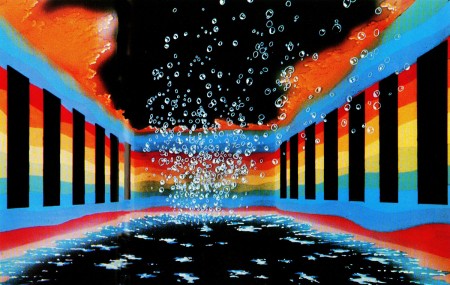
Today, animation is not just for kiddie cartoons.
The Oriental Nightfish was a short developed to
be used in the concerts of the rock group, Wings.
The above outlets for animation, theatrical features, and television are dominated by “the industry”—films made by a group of artists and craftspeople in a studio using mostly cartoon designs. It is this work that is most accessible to the general public, both actually and aesthetically. But there is another force working in animation, much less well known but gaining each year in terms of recognition and in avenues of distribution and exhibition. This is a large, vital international network of independent animation-film and -video makers who, freed from profit-motive considerations, explore alternative ways of communicating, interpreting, and expressing themselves and the world through animation. Many work for years on a short film; some subsist on canvas, or a sculptor to clay.
“Because it depends so heavily on technical expertise, we believe the medium of animation enters into the realm of art only when it has a strong personal imprint,” said George Griffin, a leading experimentalist. Griffin, whose inventive films explore the “act of art-making” in a variety of techniques from flip-books to Xeroxed graphics, last year privately published an anthology of new American independent animators.
Titled Frames, the book represents the work of more than seventy animators in this country alone. Their techniques and graphic signatures are lavishly diverse: some artists work in collage (Frank Mouris), others use optical printing (Peter Rose, Anita Thacher), or drawing on film (Steve Segal), direct three-dimensional manipulation (Caroline Leaf, Eli Noyes), rotoscoping (Mary Beams), drawing on paper (Kathy Rose, Dennis Pies), and “cel” animation
(Suzan Pitt, Sally Cruickshank).
To the independents, Griffin notes, “experimental film is not about what a work looks like, but what it does. How it invents its own form, makes its own rules, while stretching the definition of the medium of animation.”
Slowly, the work of these individualistic artists is reaching a larger public. The 1978 New York Film Festival featured a showcase of new animation, as did the USA Dallas Film Festival and the Los Angeles Film Exposition. Independent animators from around the world consistently win top prizes in animation festivals in Zagreb, Yugoslavia, Annecy, France, and Ottawa, Canada. Cable and public television stations book these works, thus introducing them to a wide scope of interested viewers. For two years PBS sponsored the International Animation Film Festival series, which booked many nontraditional animated films. A feature-length compilation, The Fantastic Animation Festival, was distributed theatrically and found particular favor on this country’s college campuses. More and more nontheatrical distributors, who sell and rent films to schools, universities, and library collections, are responding to their patrons’ interest in the new animation and are signing many experimental animators to contracts.
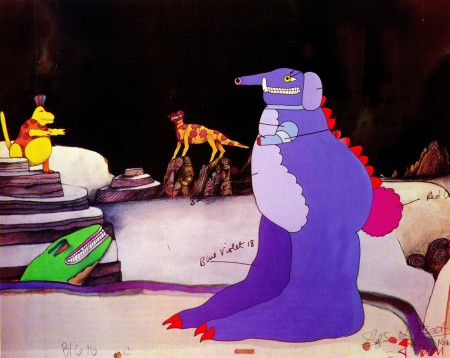
A color model from the pop-art animated feature
The Yellow Submarine (1968) indicated to the
opaquers which colors to use in the final frames.
In the beginning, naturally, all animation was experimental. Although no one knows who first discovered the magic inherent in the camera’s ability to shoot single frames of film, three pioneers defined the animation medium by experimenting and inventing the basic tools still in use today. James Stuart Blackton, a cartoonist-reporter for the New York Evening World, made Humorous Phases of Funny Faces in 1906 and used animation to promote himself and his film company, Vitagraph. The Parisian Emile Cohl made or contributed over 250 animated sequences starting in 1908; his series, The Newly weds, made in America and based on a popular American comic strip, was very influential in identifying the animated-cartoon genre with the weekly comic strip in the public’s mind. Winsor McCay, the most gifted cartoonist-draftsman of his age, tirelessly explored the possibilities of line and motion in his ten films including Little Nemo (1911) and Gertie the Dinosaur (1914)) and promoted animation on his chalk-talk vaudeville tours.
It was in 1914 that American cartoonist John Randolph Bray turned animation into a business. Bray, who might be termed the Henry Ford of animation, organized a staff of specialists doing assembly-line tasks in cartoon studios. He cannily took out patents on certain work- and time-saving inventions (the most important being clear Celluloid acetate sheets called “cels”) which enabled large numbers of films to be produced in series. Thus began the industry of animation, the mass production of cartoon films starring a parade of internationally famous characters. Often the characters came from the newspaper strips, like Mutt and Jeff. But Felix the Cat, created by Otto Messmer at the Pat Sullivan studio in New York circa 1919, was made for the screen —the first creature to express an individuality in drawings that move. Felix’s unique design and, most important, his personality profoundly influenced Walt Disney’s famous animated rodent.
The experimentalists continued to work by themselves creating films that widely diverged from the commercial mainstream. Often the influence of the avant-garde was felt in the studio product, but it was adapted into the “accepted” version —reduced for the conditioned taste of the public who rarely experienced the strong individuality of the original source. (A prime example is the preliminary work the German abstractionist Oskar Fischinger contributed to a sequence in Disney’s Fantasia [1940].) Strong, beautiful, short films of singular vision were made by animators in Europe during the period 1920-1935 and in America in the 1940s and 1950s. Among these animators were Len Lye who painted directly onto film, Lotte Reiniger who used cut-out silhouettes, Alexander Alexeiff who worked in pinscreen, John Whitney with his computer works, and Jordon Belson whose specialty was video projects.
Interest in animated films has been enhanced by a wave of printed supporting material: in the last five years, scores of periodical articles and eighteen books on all aspects of animation have been published. Some of the books deal with cartoon nostalgia (The Fleischer Story), some focus on technology and technique (Visual Scripting), others on a particular genre (Puppet Animation in the Cinema), or historical perspective (Experimental Animation: An Illustrated Anthology). Six new books in the works aim toward publication within two years.
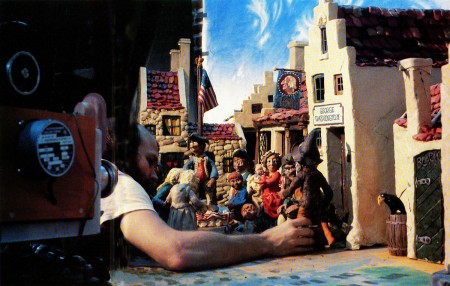
Oscar-winning Will Vinton, one of today’s innovative animators,
adjusts characters from Rip Van Winkle, a half-hour clay animation.
The current issue of the American Film Institute’s Guide to College Courses in Film and Television shows that more than sixty major American colleges feature animation workshops and/or film-tape appreciation courses in their curriculum. Most celebrated is the California Institute of the Arts, which divides its animation work-shops into an experimental group under veteran designer Jules Engel and a character-animation section headed by Disney shorts-director Jack Hanna. Many of En-gel’s students have become some of today’s most exciting independent animators and several of Hanna’s students have found their ways to jobs at Disney or other cartoon studios.
The cross-pollination of ideas gained by the proximity of the two Cal Arts animation courses is a good omen and symbol for the future of animation. The art today is undeniably vigorous and varied; computers are being developed to enhance productivity and cut production costs (such as Computer Creation’s “VideoCel” technique). The growing visual sophistication of audiences and the international exchange of ideas between the avant-garde and the industry, the new technology outlets for films and tapes, such as video-disks and home-tape consoles, make the future of animation exciting and unlimited.
- Who’s Watching Cartoons?
Most viewers are children, but there is a healthy contingent of adults, particularly for reruns of old theatrical shorts.
Tim Roberts, head of creative services at New York’s Channel 5, notes that his station receives a “steady number of phone calls from adult viewers” inquiring as to the titles of the shorts shown in the daily series. “Some people want to see a certain favorite, like Bugs Bunny or Woody Woodpecker, but most of the callers have videotape machines and want to tape certain films to add to their cartoon collections.”
Last November Channel 5 presented a half-hour Cartoon Film Festival for one week in prime time (8 P.M.), with interesting viewer results. Diane Sass, vice-president of marketing and research at Channel 5, consulted the Arbitron report, a book of TV viewer demographics and noted that the festival received a ten rating, which she said is “very good. The usual programming in that time slot is a game show, ‘Crosswits,’ which usually pulls a six to seven rating.” More interesting was the breakdown of viewers according to age. The Cartoon Festival, said Sass, “had a total viewing audience of 1,217,000. Of that 438,000 were kids, 225,000 were teenagers—age twelve to seventeen—and the majority of viewers, 554,000, were adults, eighteen-plus.”
A guest fellow at Yale University teaching animation history, John Canemaker is the author of The Animated Raggedy Ann & Andy—An Intimate Look at the Art of Animation: Its History, Techniques and Artists and makes animated films and documentaries about animation.
Animation &Animation Artifacts &Disney 03 Nov 2010 07:22 am
Milt Kahl’s Alice – 1
- Here’s a scene from Alice in Wonderland that was animated bit Milt Kahl. I’ll post the first half of the scene here, and will follow with the rest next week. I also have a scene that follows, and I’ll post that, as well.
Thanks to Lou Scarborough Jr. for the loan of the art work.
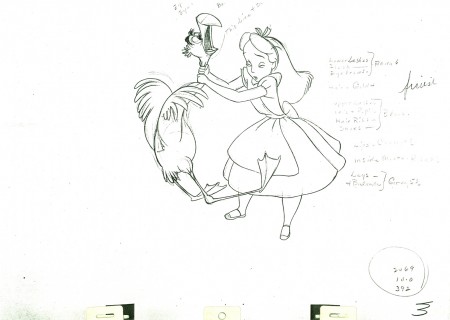 3
3(Click any image to enlarge.)
The remaining drawings will be added next week.
_________________________
Here’s a QT movie of the action layed out above.
Books &Independent Animation 02 Nov 2010 07:25 am
Just Published
The NYTimes features a longish article about Sylvain Chomet’s film, The Illusionist. It appeared in Sunday’s paper.
Likewise, the NYTimes also has an article about Megamind. It’s essentially a photo essay.
- George Griffin sent me a couple of links: one to an article at ArtForum Magazine about the scupture of animation artist Robert Breer; it’s a good read. Take a look here.
There’s also a spot called “Dot” from Aardman Animation that’s worth viewing at YouTube. Here It reveals what went in to making the world’s smallest character animated film and how it was shot using a Nokia N8.
Book Review
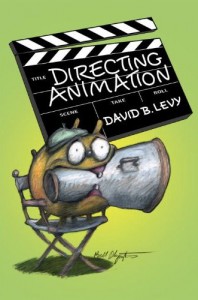 - David Levy has fashioned an exceptional career for himself. He’s been producing animated shorts, teaching at the School of Visual Arts, and writing books. It’s the latter career choice that I’m interested in, today. Dave’s got a new book hitting the market today, and I’d like to talk about it.
- David Levy has fashioned an exceptional career for himself. He’s been producing animated shorts, teaching at the School of Visual Arts, and writing books. It’s the latter career choice that I’m interested in, today. Dave’s got a new book hitting the market today, and I’d like to talk about it.
Directing Animation is published by Allworth Press, and it’s his third book and a good companion to the other two: the first, Your Career in Animation: How to Survive and Thrive and the follow up, Animation Development: From Pitch to Production.
David is concerned with the nuts and bolts of animation. He wants to reveal how things work. In the first book, Your Career in Animation: How to Survive and Thrive, he focussed on how the individual should work in an animation studio. It was something that hadn’t been touched on before: proper manners and activities within a studio environment; essentially, how to work with others. The second book, Animation Development: From Pitch to Production spoke to those were trying to develop a series for television and how to present it to those in the position of power. It perfectly, again, taught the proper protocol for delivering your message and selling yourself. Neither of these books, really, had any predecessor.
This third book, Directing Animation, is also something original. It talks about the person who controls a film. There are many book on live-action directing, none that I know of – except this one – for animation. David spends much of his time talking to professionals and gives a guide to working within a group, a studio structure. He also spends plenty of space talking about the Independent animation Director.
I’m mentioned quite a bit in the book, as is Bill Plympton (who did the cover art for the book.) We’re the old timers, it would seem, and a lot of other younger directors such as David Palmer, Tatia Rosenthal and Ian Jones-Quartey get plenty of coverage. Even Web Directors, such as Xeth Feinberg, are discussed.
I’m sorry there isn’t time spent discussing the history of animation direction with some of the past geniuses who set the way: Chuck Jones, John Hubley, Bob Clampett, Jiri Trnka and the many others with strong personalities. It would be nice to see what made those people strong directors and how we can learn from their films.
The book gives more of an overview than an actual how-to approach to the subject. Unlike a book on how to direct a live-action film, there’s little talk of the language of film; no mention of such things as: “the inadvisability of cutting from LS to CU or back”, “the complications of shooting a pull back – zoom out” or even “crossing the 180°”. No, this book is more about getting the job and what’s expected of you. However, using a lot of anecdotes and answers to questions from the directors chosen, a lot is revealed. The subject takes us from TV series to animated features to web productions. A lot to cover, and it does it gracefully.
The book is a good companion to those questioning the career choice. However, it takes a lot of experience to do it properly. The knowledge of film structure and live action history has a lot to do with properly directing a film – even an animated film. Hitchcock once said that there’s only ONE possible setup for a scene, and you had to find that setup. In animation we usually jump from one hyper dynamic pose to another; it’s not film language but comic book language. A book can only tell you so much; the experience will reveal much more.
I’d say that if you want to direct, you should make a film – by yourself, if necessary. You’ll learn a lot of mistakes to avoid for the future and get your directing career going.
The book’s a great read, as are all of David’s works. I’m looking forward to his upcoming book about Bill Plympton. This is something different for David, and I’m curious to see how he’ll approach it.
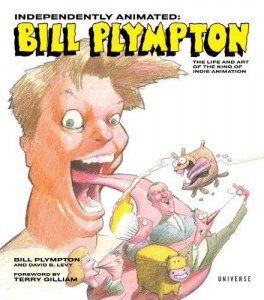
_____________________
